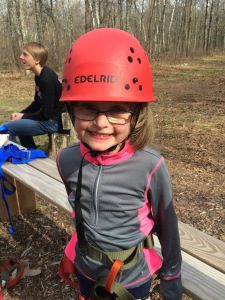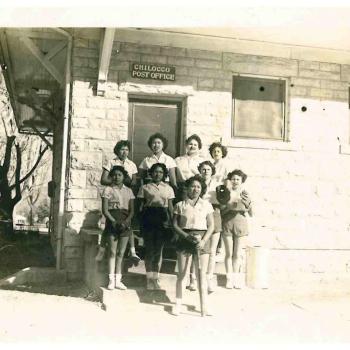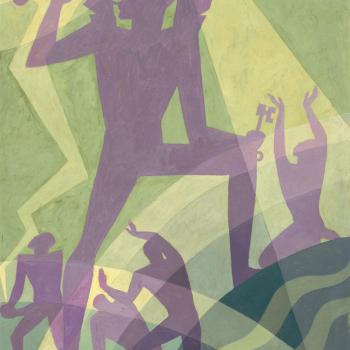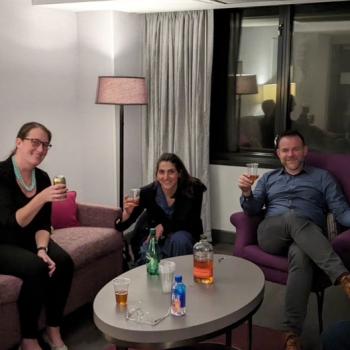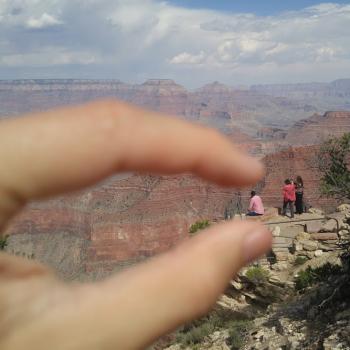Today I want to continue our back-to-school theme. Having talked about the importance of teachers last Tuesday, I now want to turn to students themselves. I’ll do it by sharing a story about my daughter Lena, who was six years old when she came to a Bible camp in northern Minnesota one weekend in May 2016. For me, what happened has become a parable about learning and courage.
As we stood in front of the climbing wall at Covenant Pines Bible Camp that afternoon, all I could think was, “I can’t believe Lena wants to go up that thing!”
See, Lena is generally much more cautious than her twin brother, Isaiah, who had spent a fair amount of our church’s family camp weekend up north playing games with the bigger kids. And just minutes before we got to the climbing wall, neither of my children had shown the slightest interest in trying the camp’s other thrill-seeker activity, which works like this:
So when we ambled over to check out the climbing wall, I felt pretty sure that neither Lena nor Isaiah would want to strap on a harness. I’m terrible at estimating these things, but it seemed like it was at least 30 feet high — and that was just to give you the chance to climb a pole to the precarious perch where a staff member waited to hook you to a long zipline that stretched off into the forest.
You could triple my salary and still not convince me to do either the climbing wall or the zipline. The only thing that scares me more than heights is hurtling along at fast speeds.
But as those thoughts ricocheted through my mind, Lena tapped me on the leg, half-smiled, and said, “I think I want to do that.”
Ever since we’d arrived at Covenant Pines, she had been having fun riding a much lower zipline over at the camp playground, but I could tell that the height was making her nervous. “Are you sure, honey?” She gulped and looked like she was rethinking the idea. But after watching a couple of friends do it successfully, she nodded more firmly and went over to get suited up.
Finally, it was her turn. Lena stretched her already-long arms and legs into impossible configurations and clambered up the wall. Without so much as a pause to catch her breath, she climbed the ladder to the start of the zipline.
And stopped.
The counselor up there gently tried to talk her into finishing the activity, but Lena was obviously terrified and wouldn’t go any further. So down she went.
Sobbing and shaking, she fell into my arms as others quietly removed the harness. I tried to reassure Lena, but finally I just had to carry her away.
But as we found Isaiah and started to head back to our room to get ready for supper, Lena collected herself. She turned her head into my ear and whispered, softly but firmly: “I want to try it again.”
I know this sounds ridiculous, but…
It felt like a moment in a Best Picture nominee. Violins swelling, camera cutting back and forth between close-ups of our faces: mine confused, then concerned; hers determined, never more serious…
“I mean it, Dad. I want to try again.”
I didn’t understand it the first time, and even less the second. But I could tell that this was an important moment in her young life. So I set her down and walked her back towards the climbing wall, holding her hand more for my sake than hers.
And back into the harness and up the wall she went. She got to the top and the zipline and… Well, I’ll shut up and let the moment speak for itself.
Even rewriting this two years later, I still can’t believe that she went back. (When we returned to Covenant Pines last year, she headed straight for the climbing wall and zipline without a moment’s hesitation… then tried the “big swing.”) No matter what else happens, I have a feeling this moment will remain one of the top three in my life as a parent.
But as a professor, her story has also become a kind of parable about student learning.
First, it reminded me that, for some of my students, my class is the thirty-foot climbing wall that ends with them hurtling down a zipline. To think critically about their own assumptions, to question their own beliefs, or to see the world through the eyes of someone they were prepared to see as their enemy is terrifying. To then be asked also to give a twenty-minute oral presentation or write a twenty-five page paper feels like coming to the top of a steep climb and realizing that there’s another level of fear to overcome.
Not all accept that challenge — or, if the class is required of them by a curriculum, they find ways to protect themselves from the scary work of genuine questioning. But it’s too easy to smugly deride undergraduates, who supposedly grow ever more fragile with each passing year. Seen from a different angle, I’m actually surprised and grateful how many of them are willing to take the intellectual and spiritual risks inherent in a liberal arts education.
Lena’s experience even makes me wonder if I’ve talked too much about such an education cultivating virtues like humility and empathy, and not enough about how it inculcates perseverance and courage.
But more importantly, the parable of Lena and the zipline makes me realize that we who teach in college sometimes take too much of the credit for the growth of our students.
It’s not that I don’t think we provide a transformative education, and I’ll continue to make that argument in response to those who would question the value of what we do. But the transformation we promise our students began long before they arrived in our classrooms, and they are not passive participants in that lifelong process.
About ten years from now, someone very much like me will give my daughter a challenge in some college course. If she accepts the risk it entails, her decision might have little to do with the skill of that professor and much to do with what she learned, thirty feet up in a forest, when she was six years old.
Or what she learned on suburban baseball fields this summer, where Lena spent two months as the only girl on her team, but worked hard and was rewarded with a spot in the league all-star game — not only for her growing skill, but for her treatment of teammates and opponents. Or what she learns day after day on the bench of our out-of-tune piano, practicing over and over until she masters another technique and another song.
Hard as it is, all that learning is easier because people encourage her along the way. Listen to the sounds of people cheering in the background of the video above. Notes of my pride and relief are in there, but most of the noise comes from people at our church who were just happy to witness Lena’s success. Over the last two years, some of them have continued to speak into her life as Sunday School teachers, AWANA leaders, and VBS volunteers.
So when she arrives in a college classroom ten years from now, Lena will be building on the work that she has already undertaken… by herself, but with the support of her parents and brother, plus her friends, schoolteachers, camp counselors, youth pastors, mentors, coaches, and many others.
At that point, professors like me will join that community — that “cloud of witnesses,” helping her “to run with perseverance the race that is set before” her. I hope they will challenge her as much as she challenges herself. But equally, I hope that they will support her as much as all those others have.
For now, I’ll turn that hope back on myself and ask what I’m willing to do for the students entering my classrooms next week. Will I commit to challenge them to take the first step up their climbing wall and then zip down their line? But as importantly, will I cheer them on once they reach those points of decision? Will I encourage them?
That is, will I en-courage them? Will I recognize moments of fearful hesitation and offer the right word of reassurance? And if they fail, to help them pick themselves up and do it all over again?
I pray that I will. Because believe me: the only thing better than a student telling you, “I think I want to do that,” is when they say later, “I want to try it again.”
This post was adapted from one published earlier at The Pietist Schoolman.


